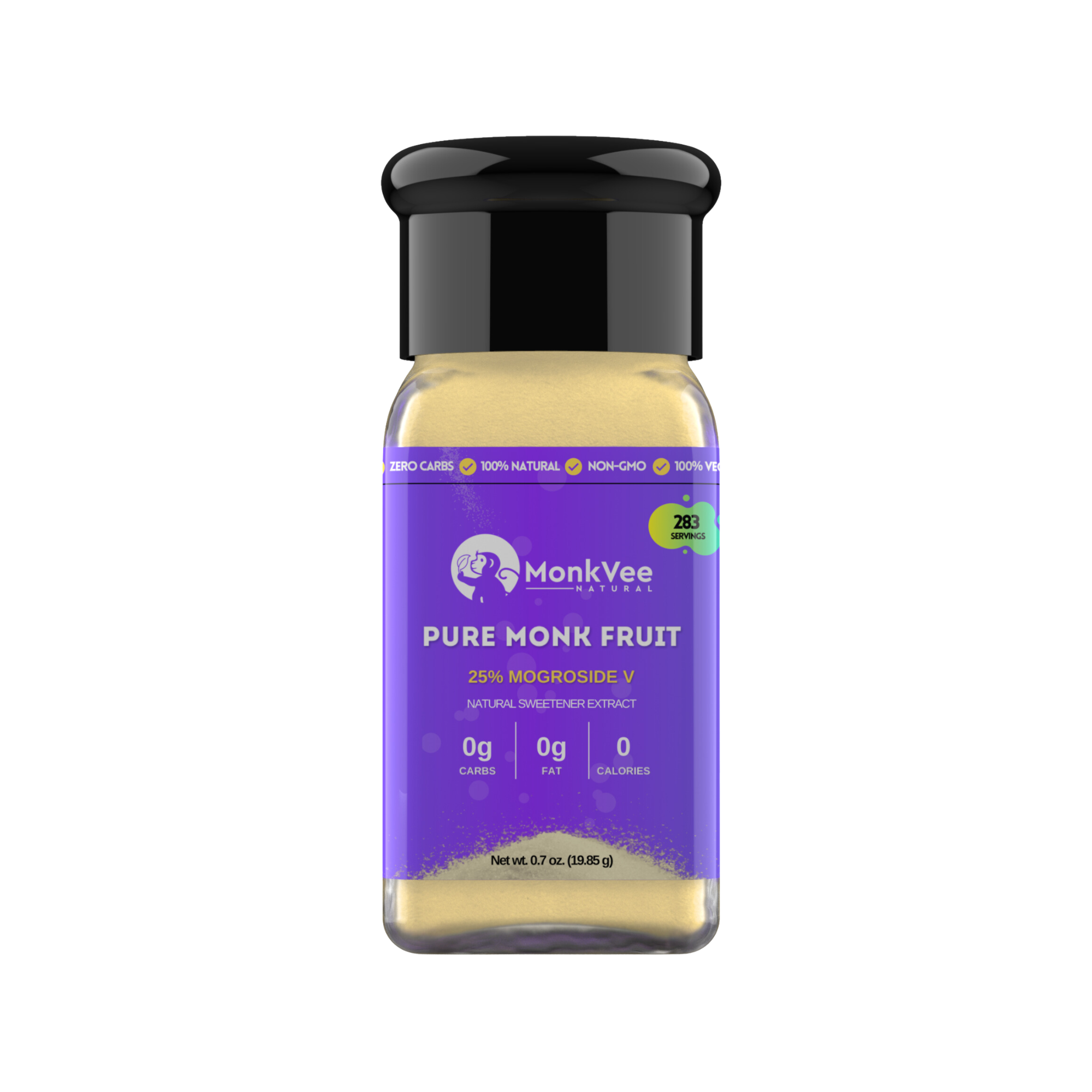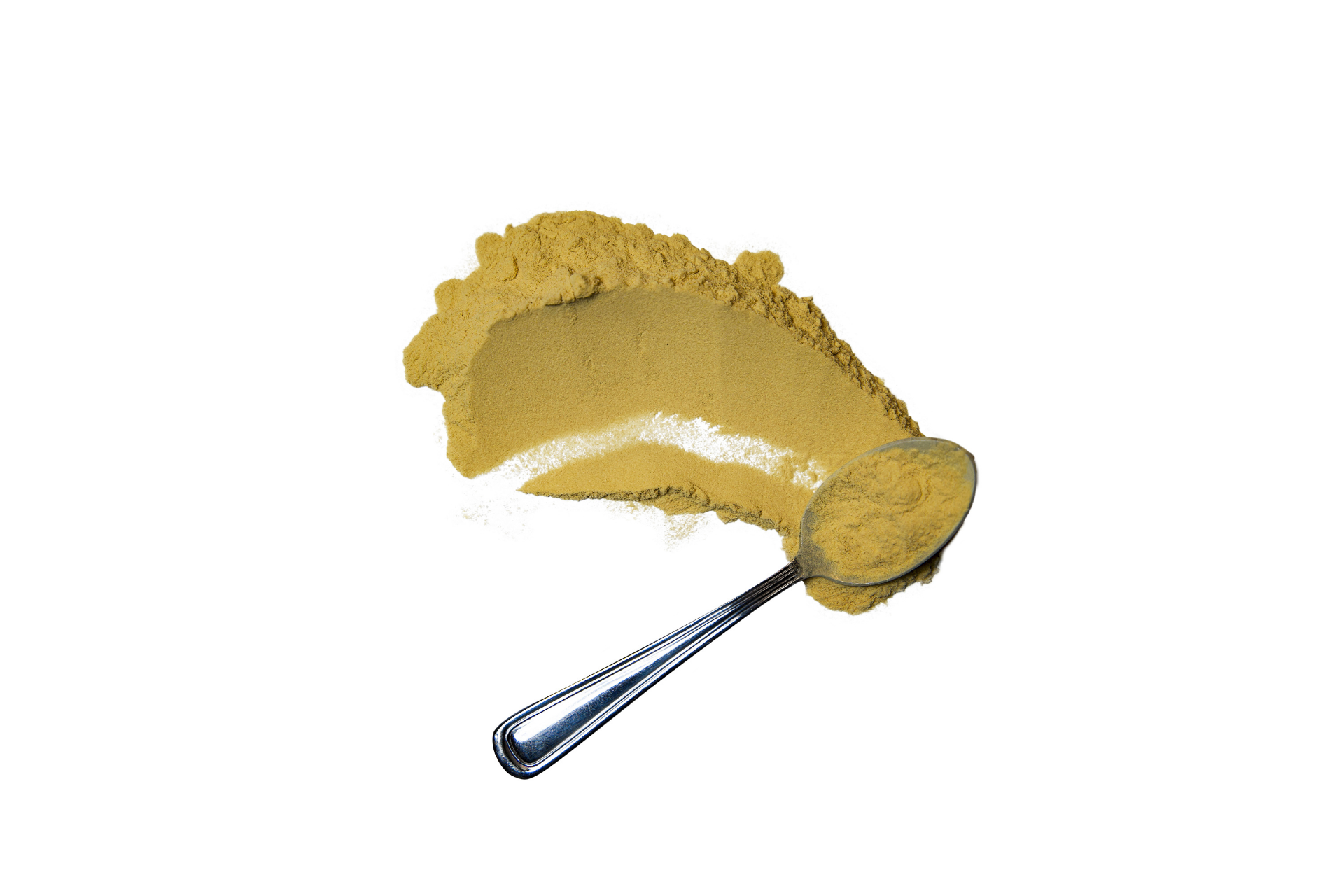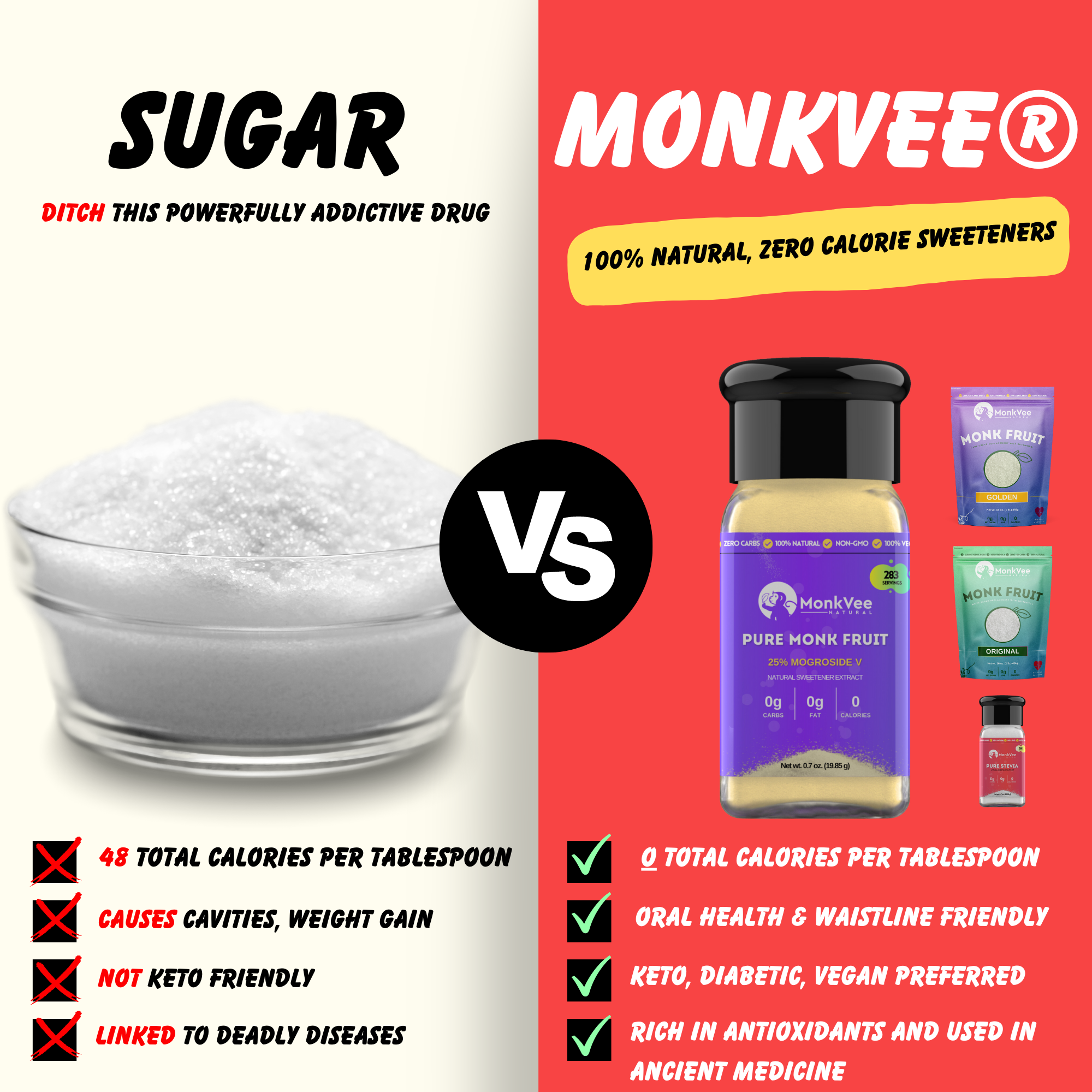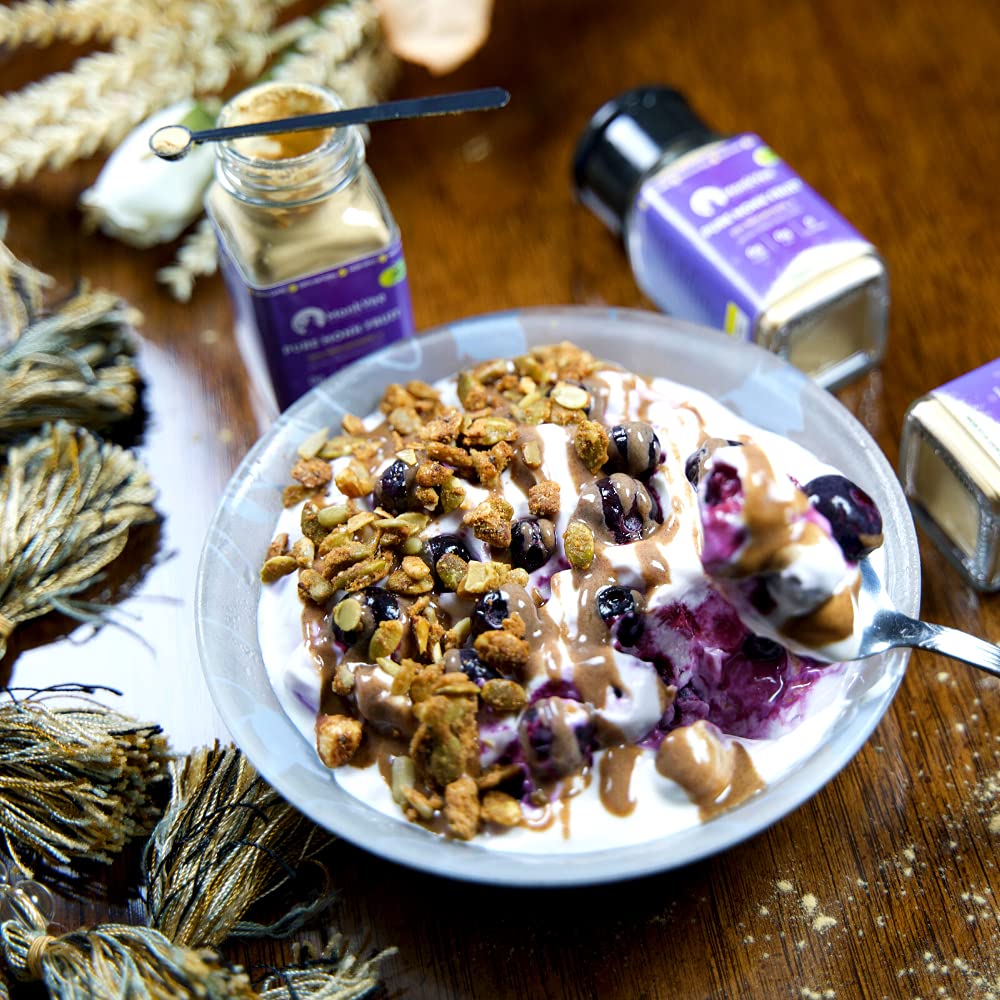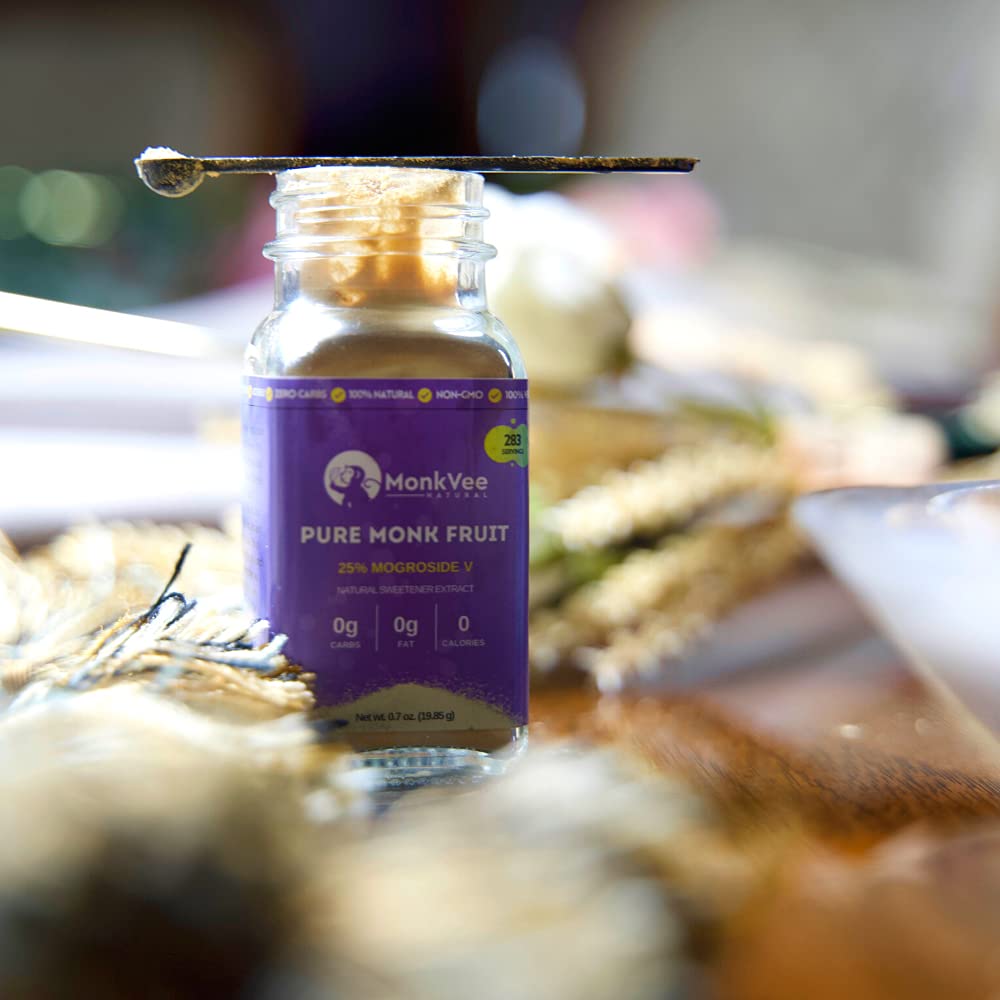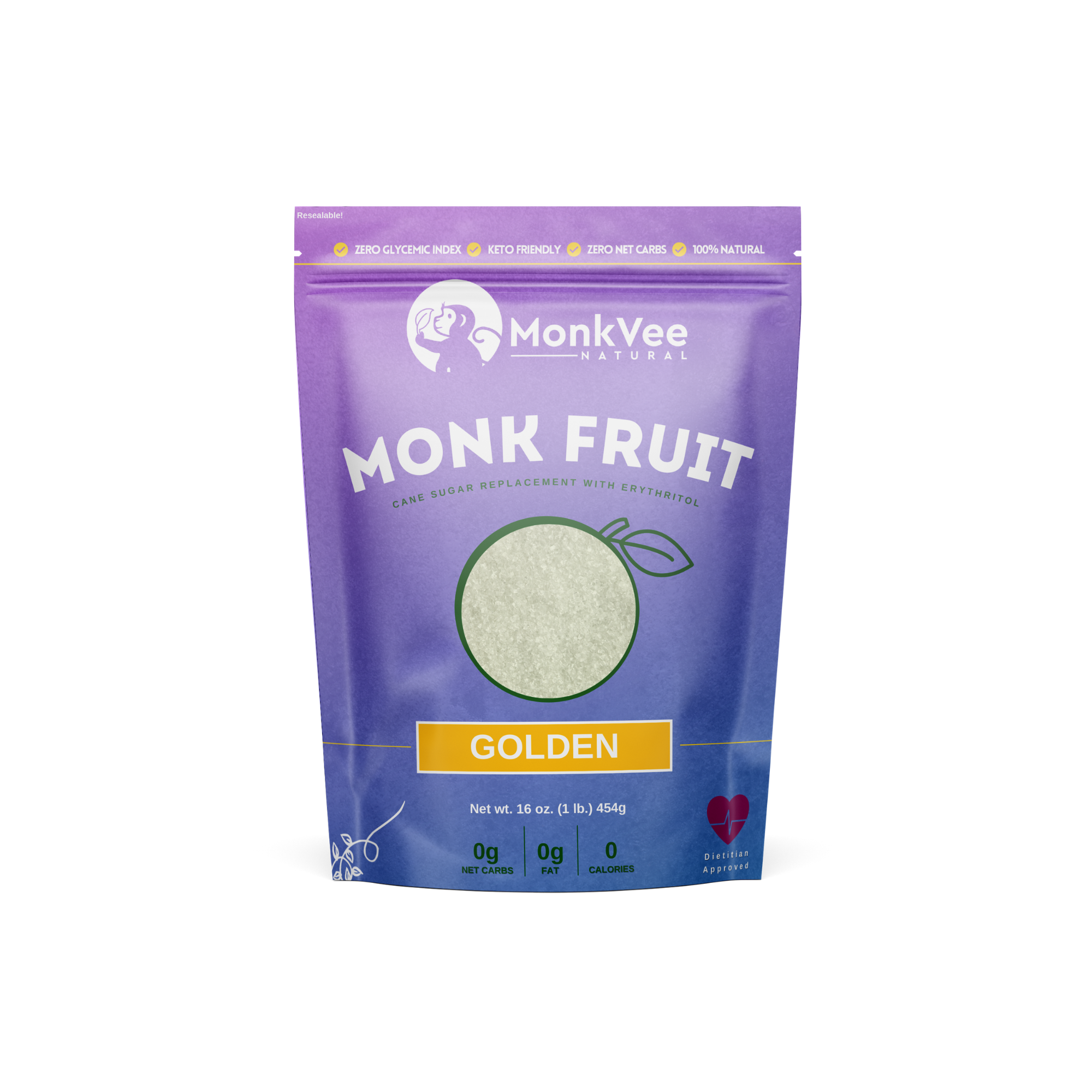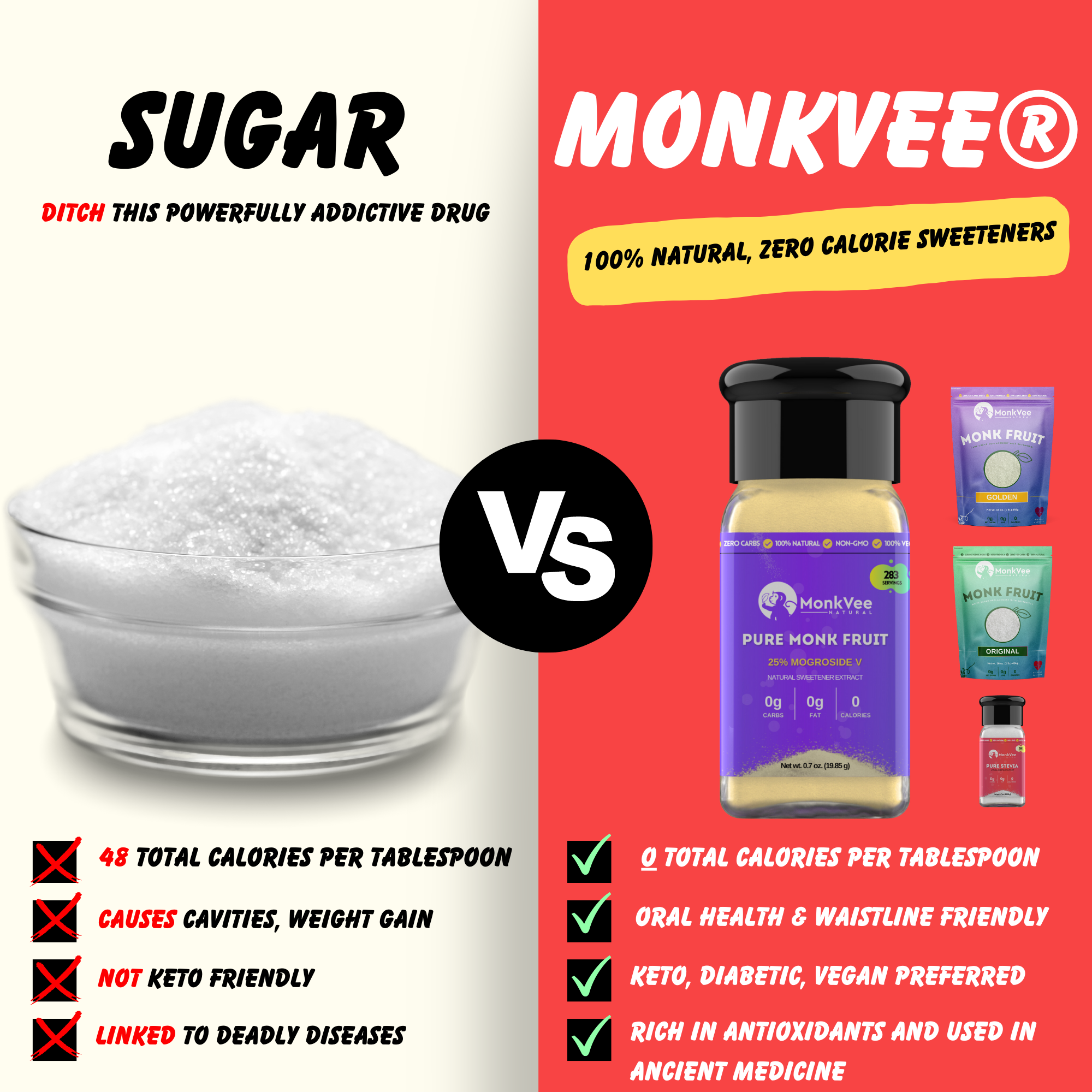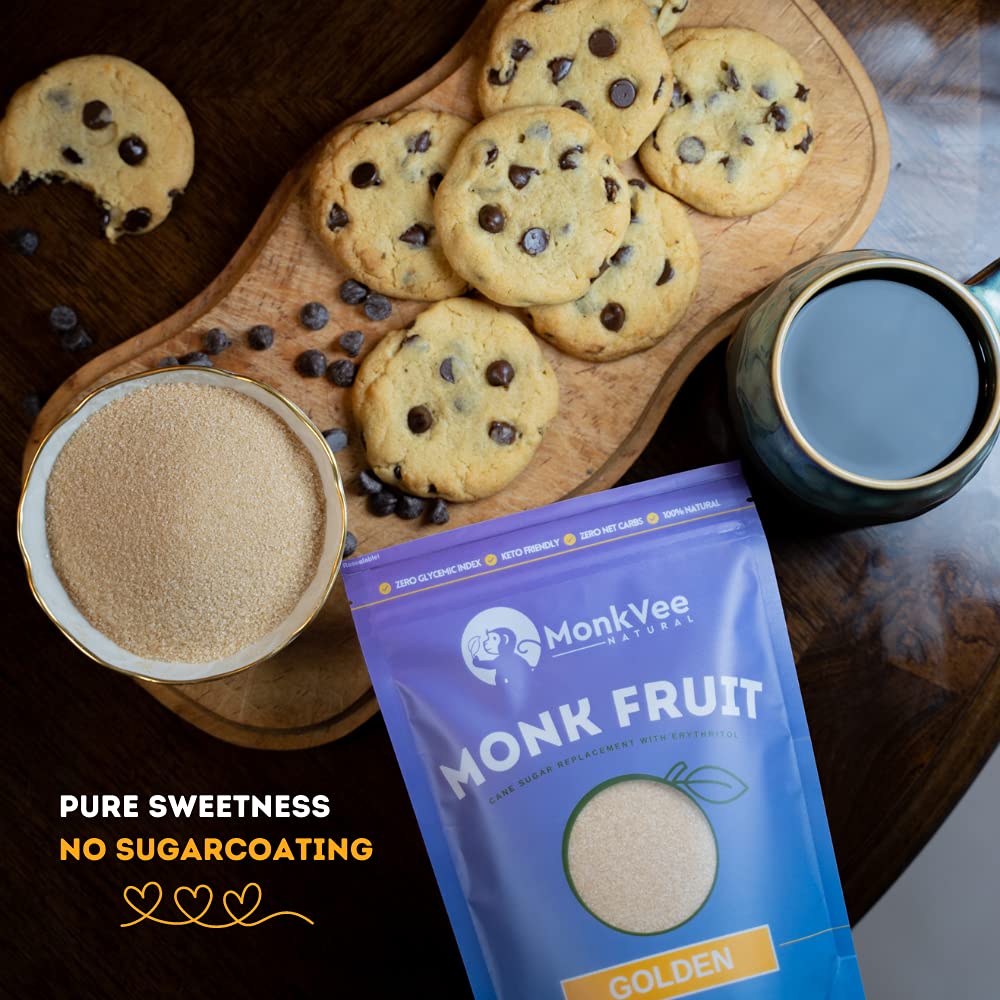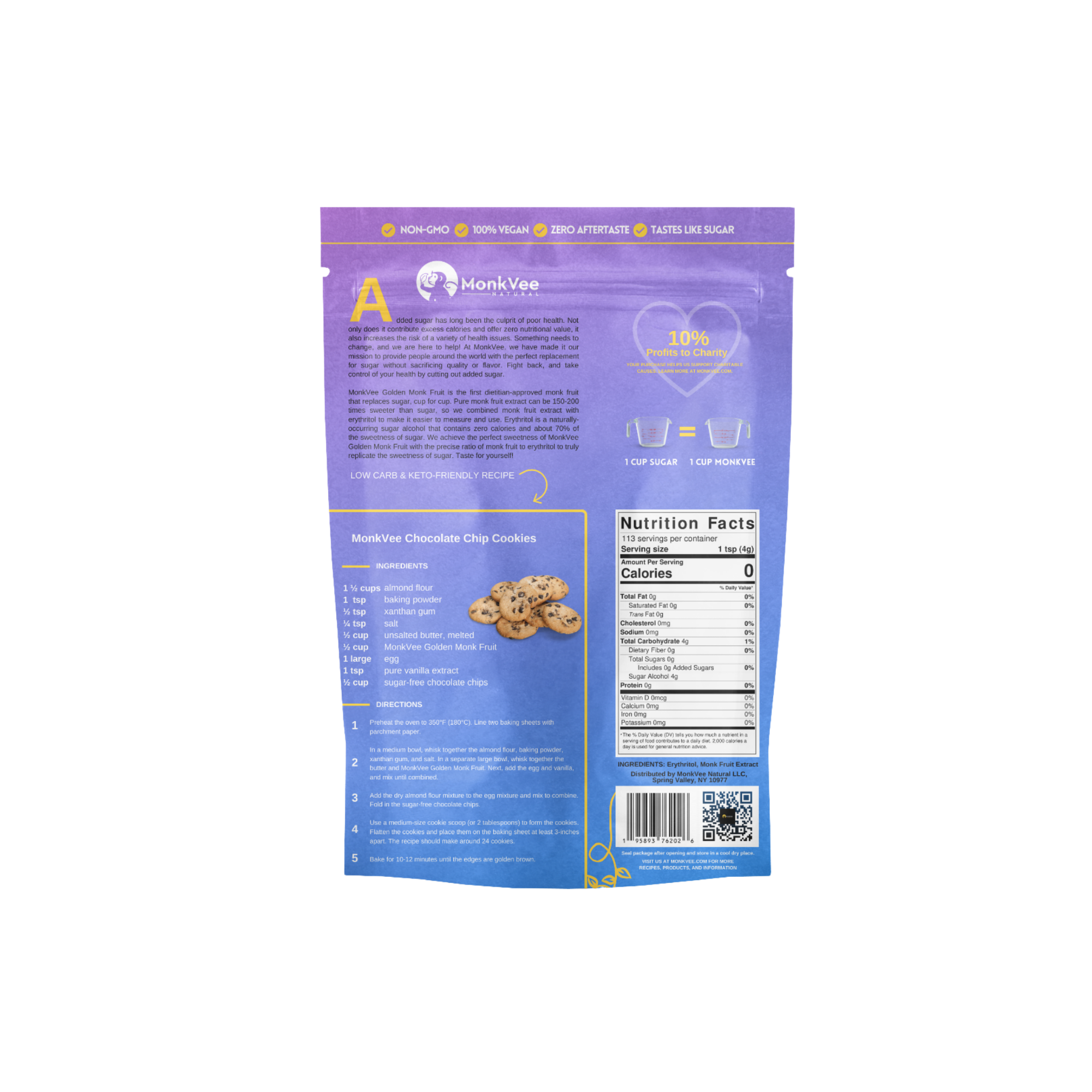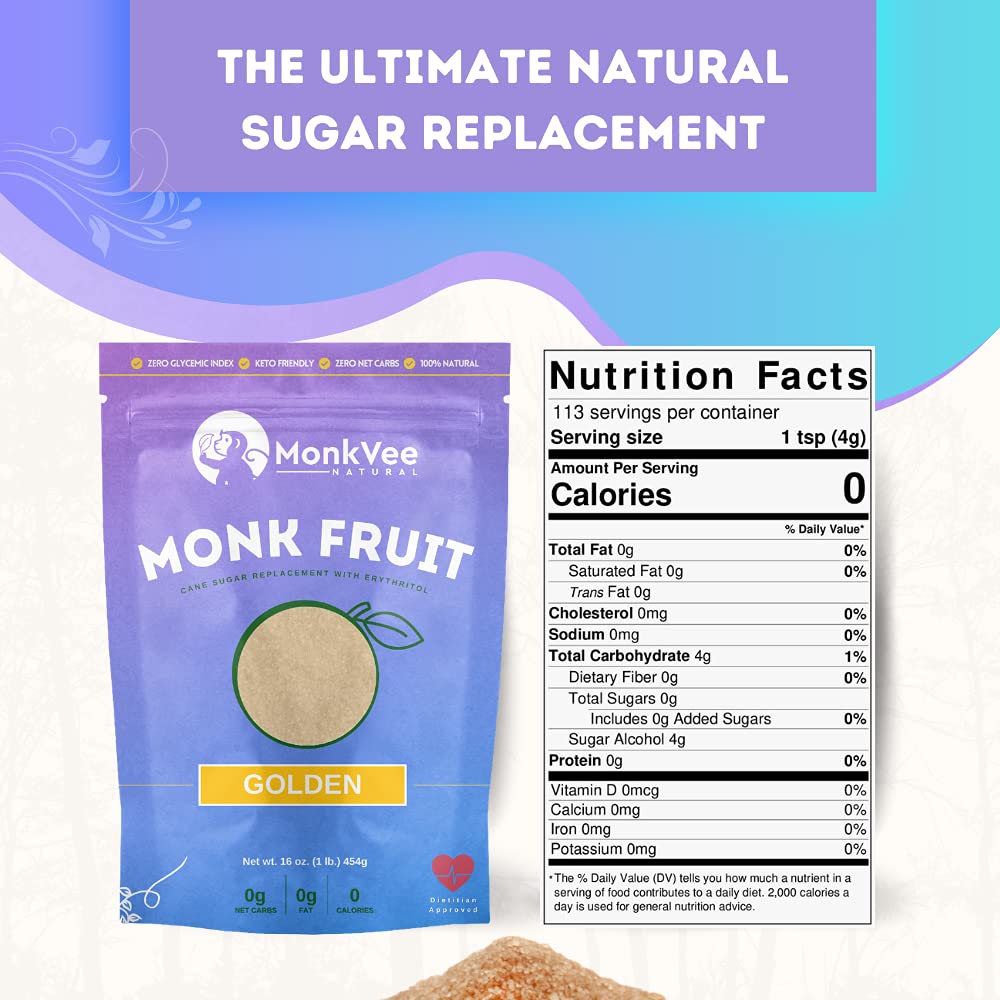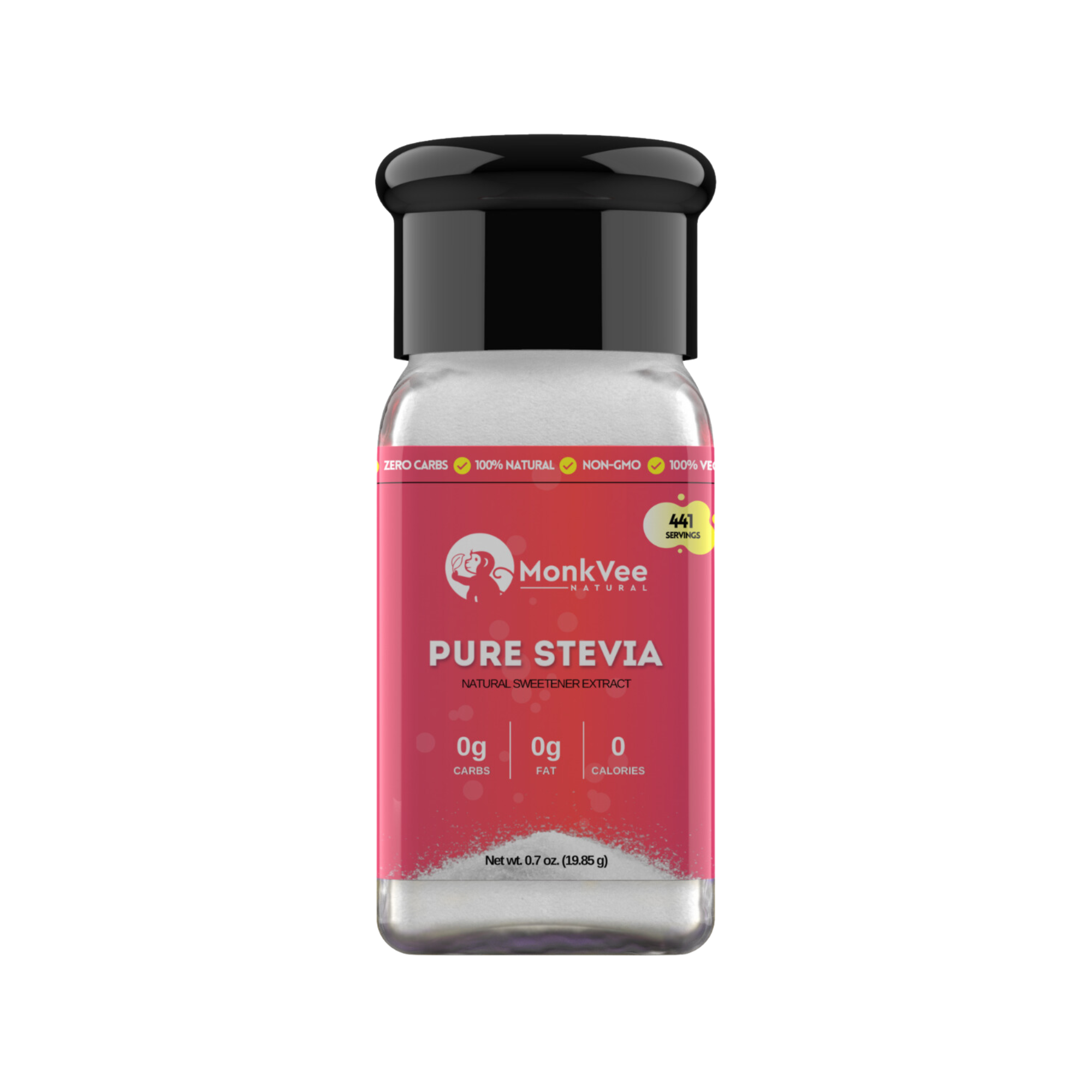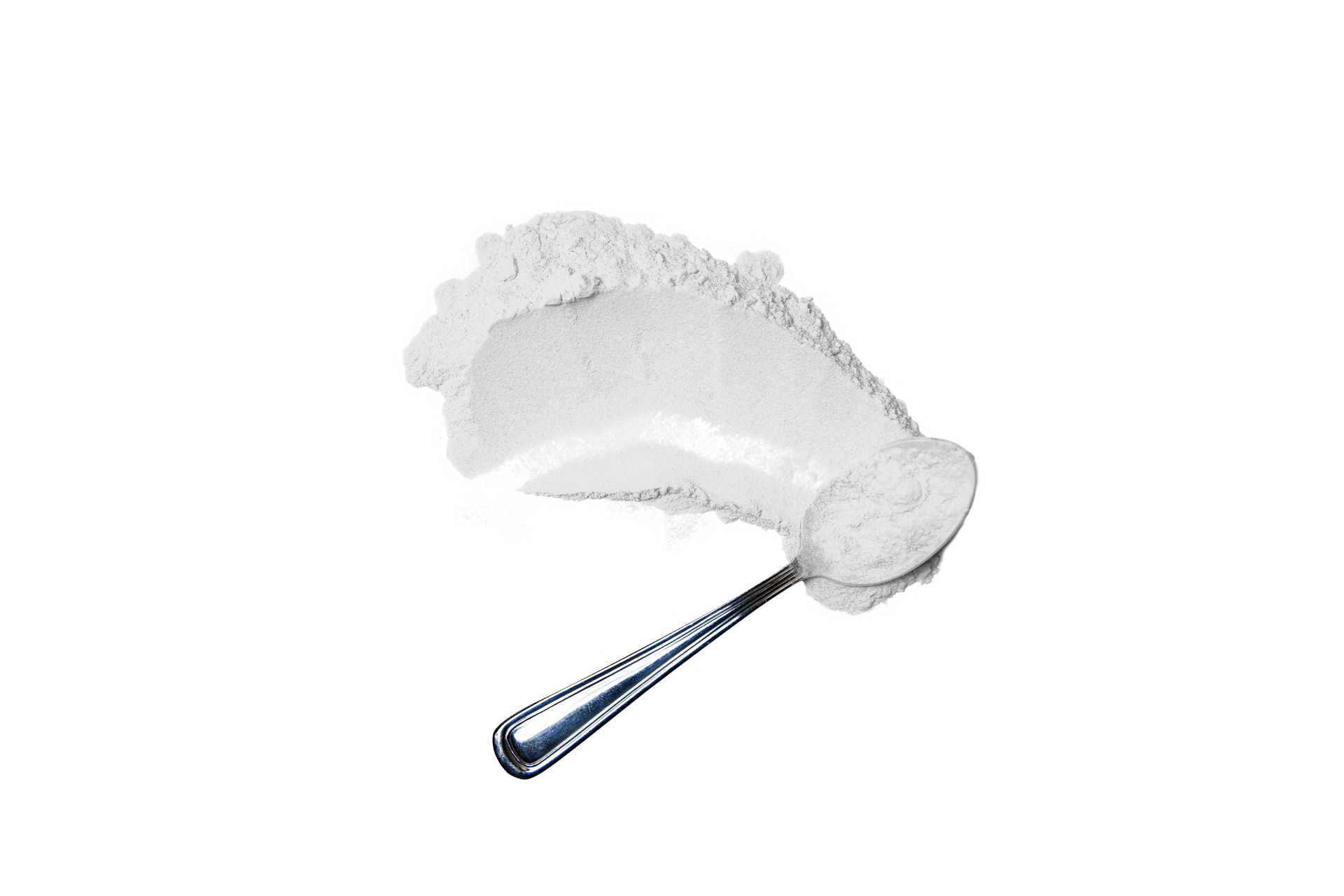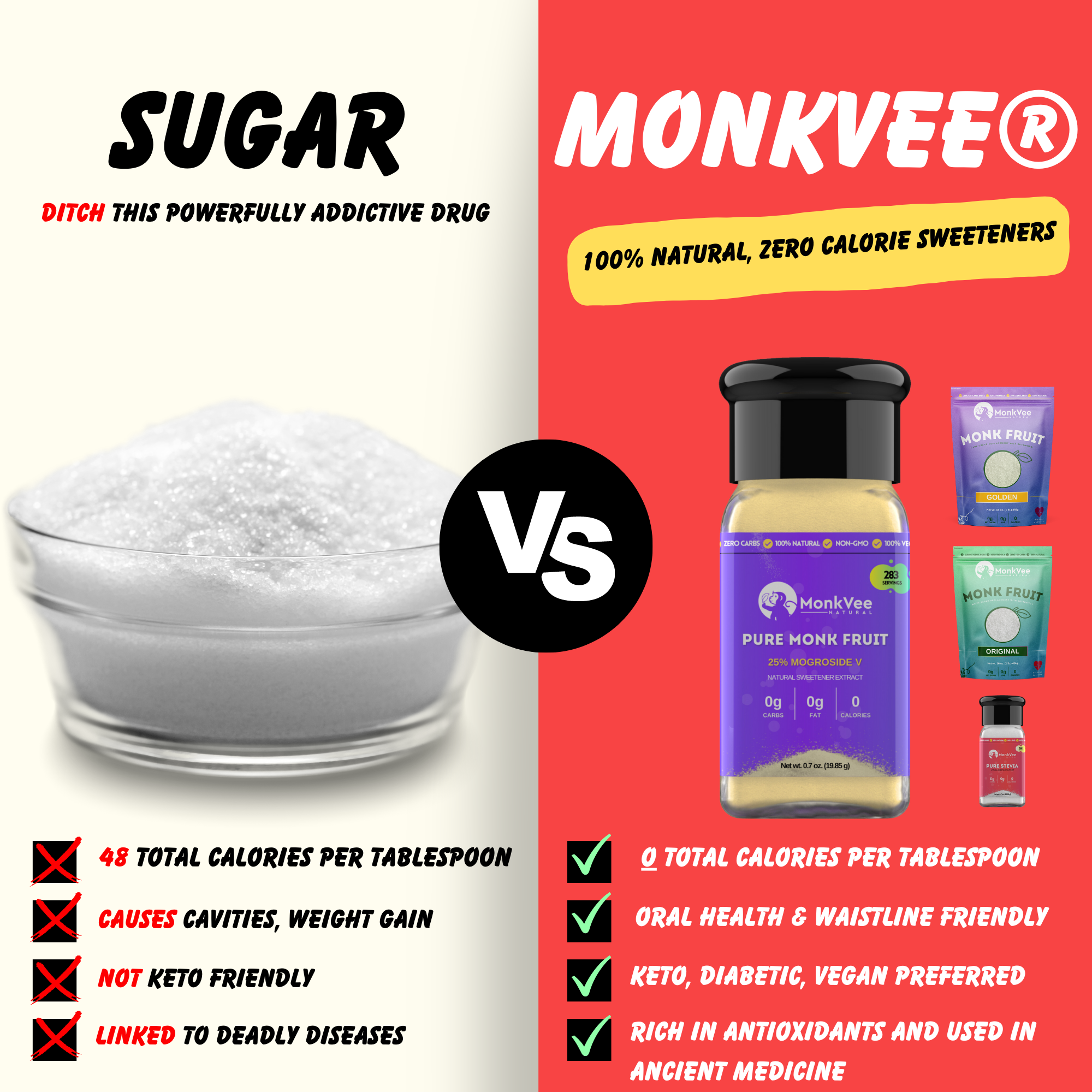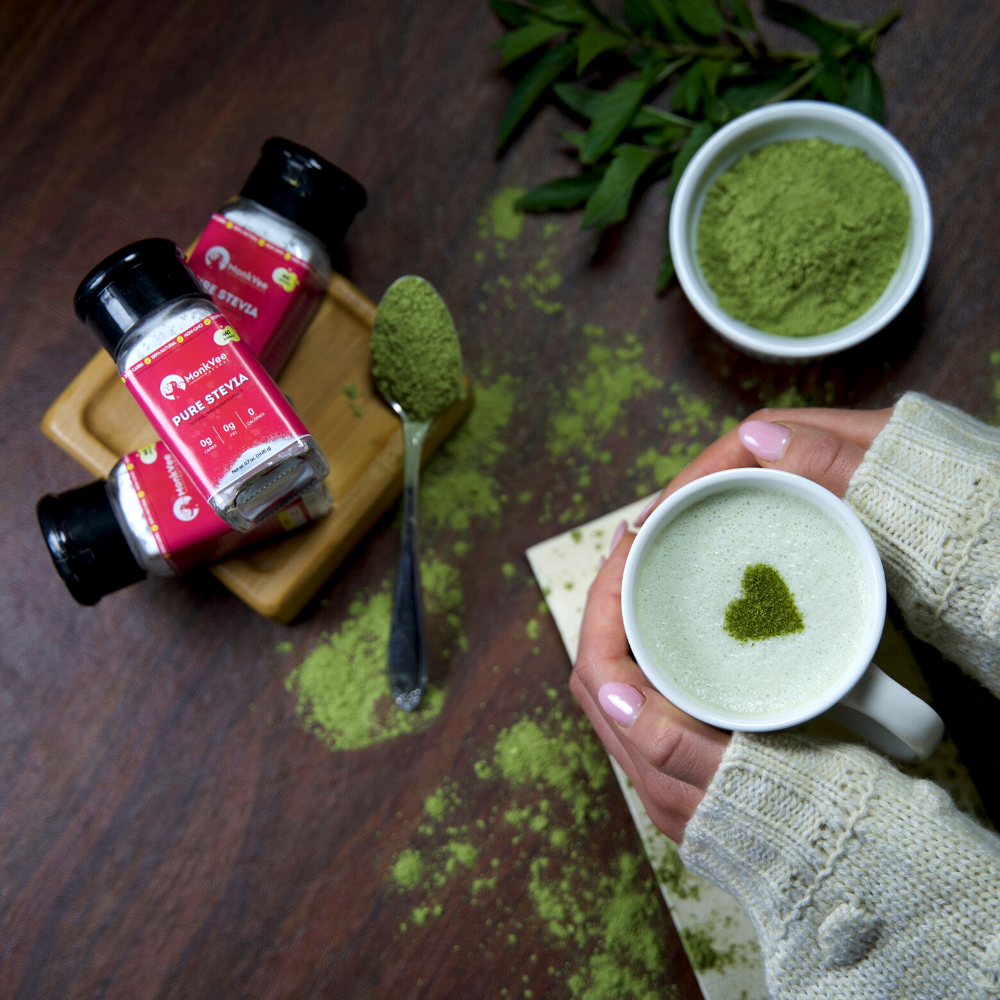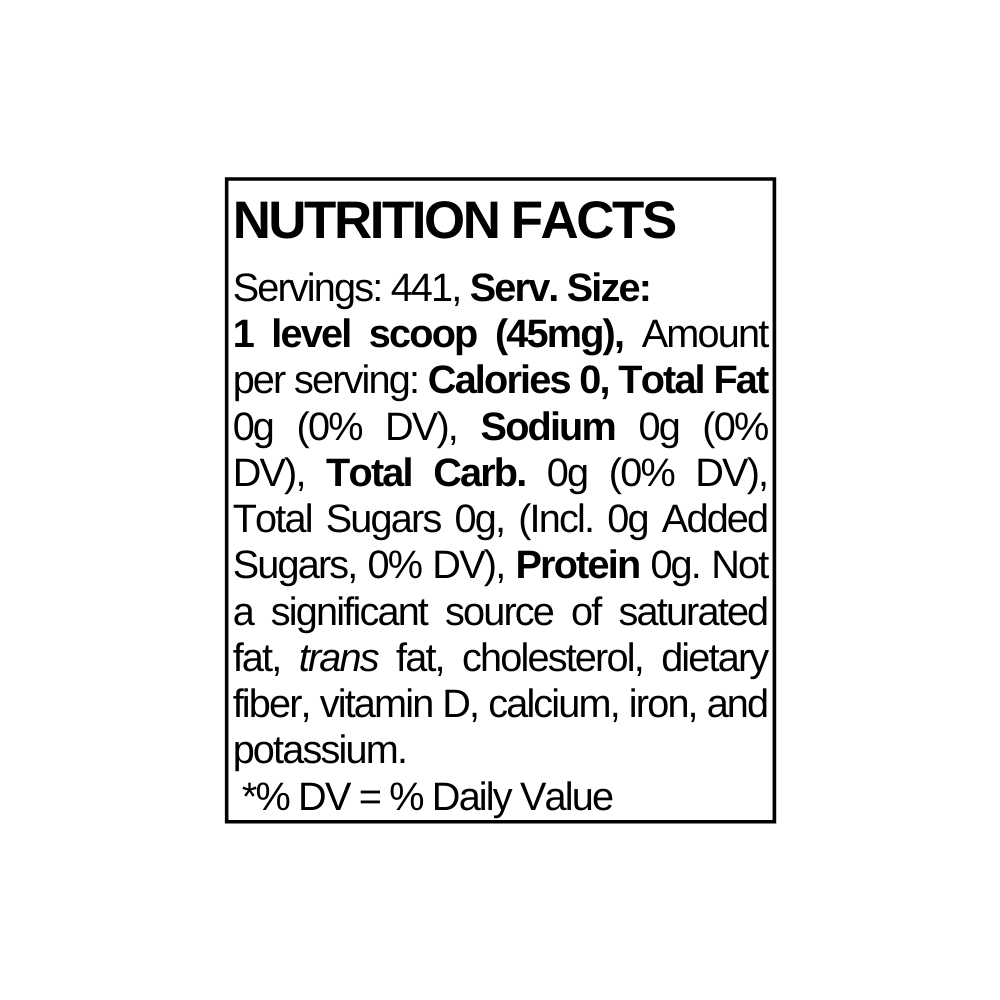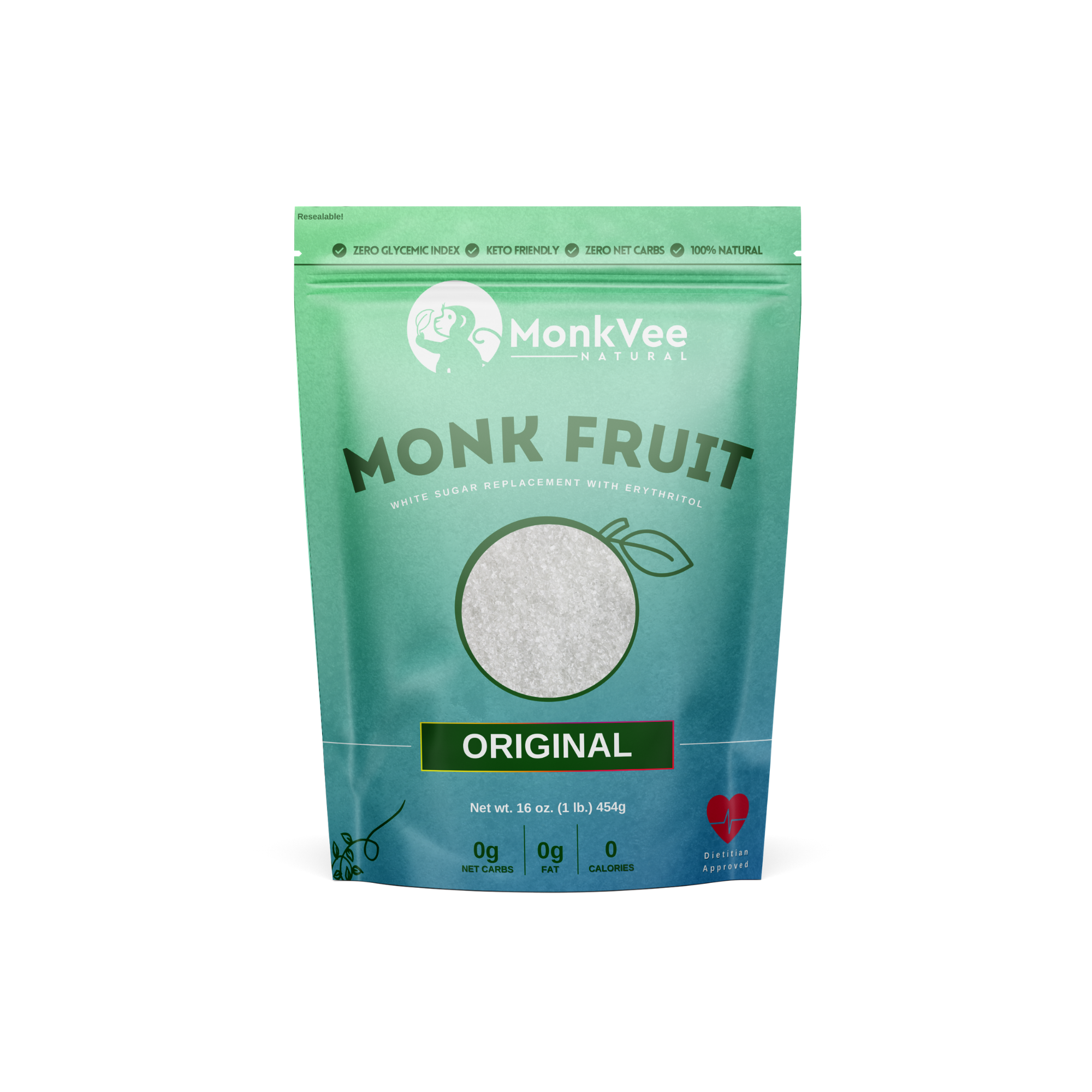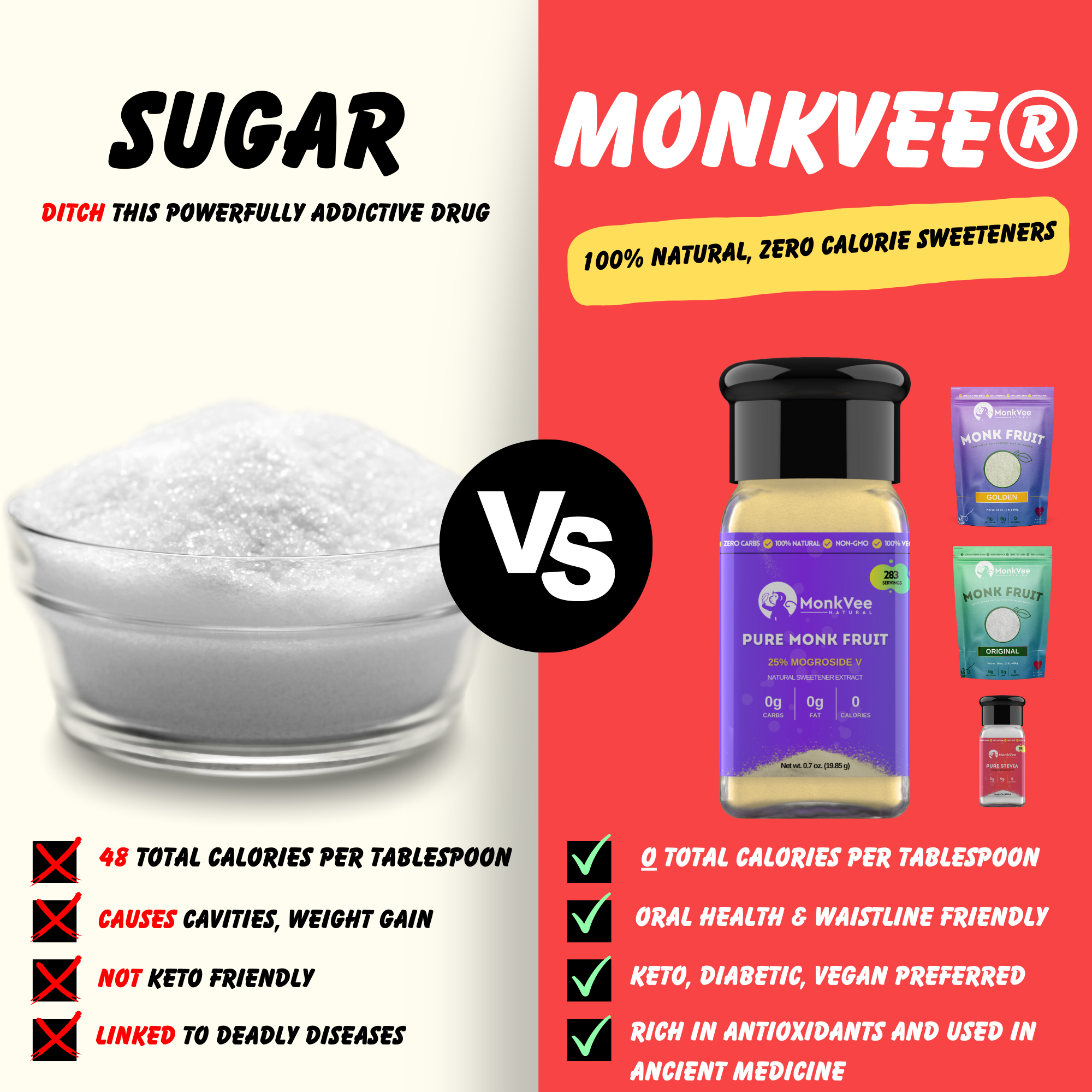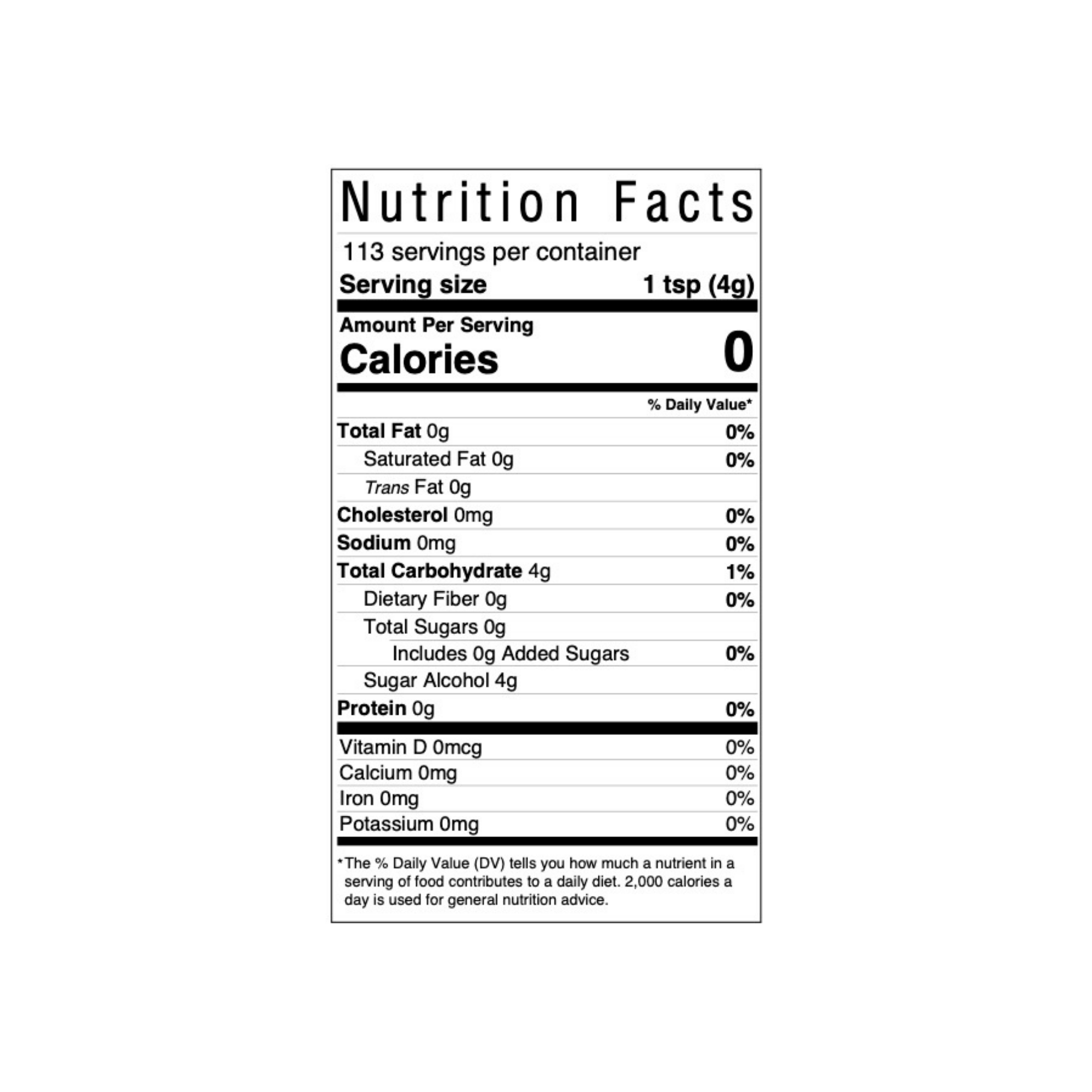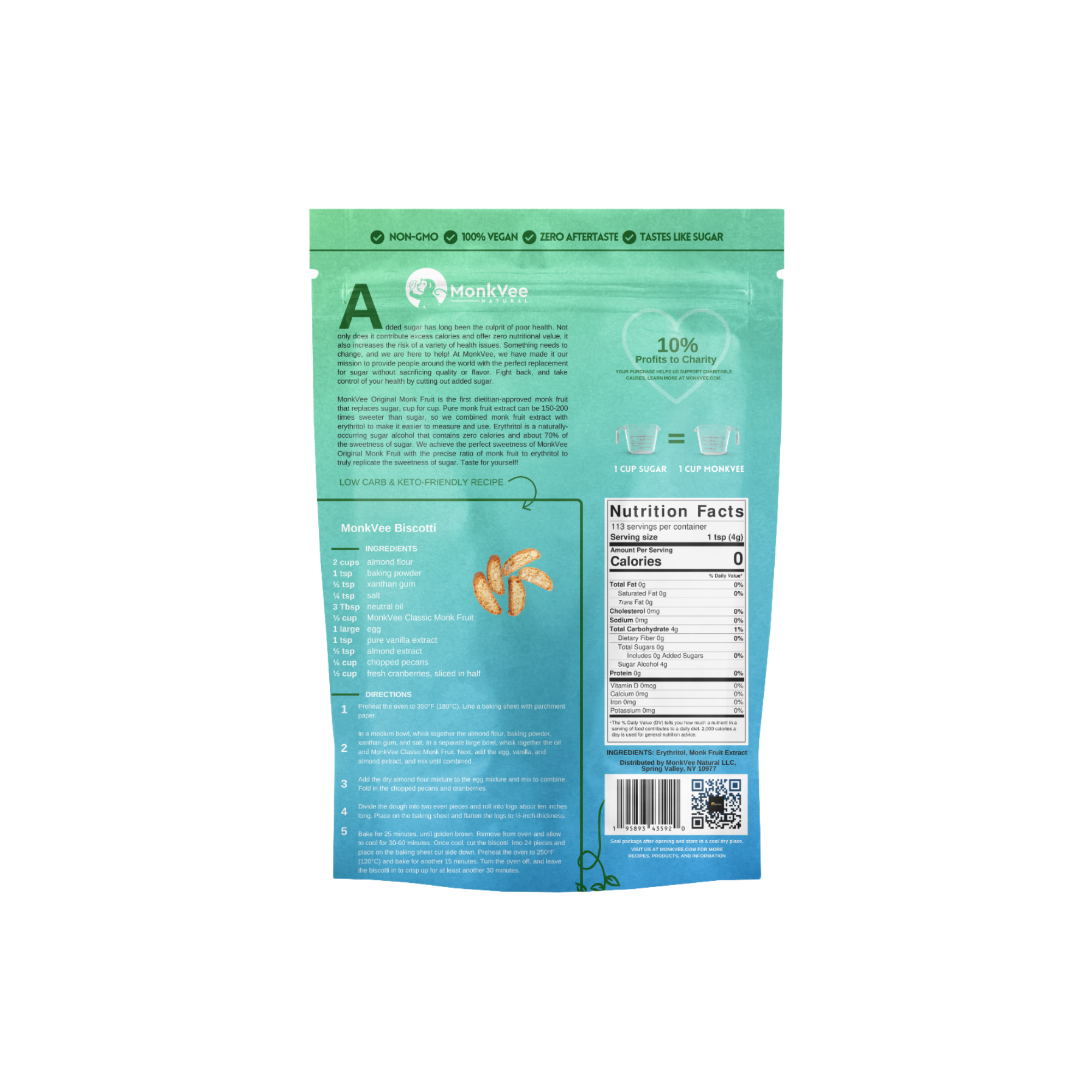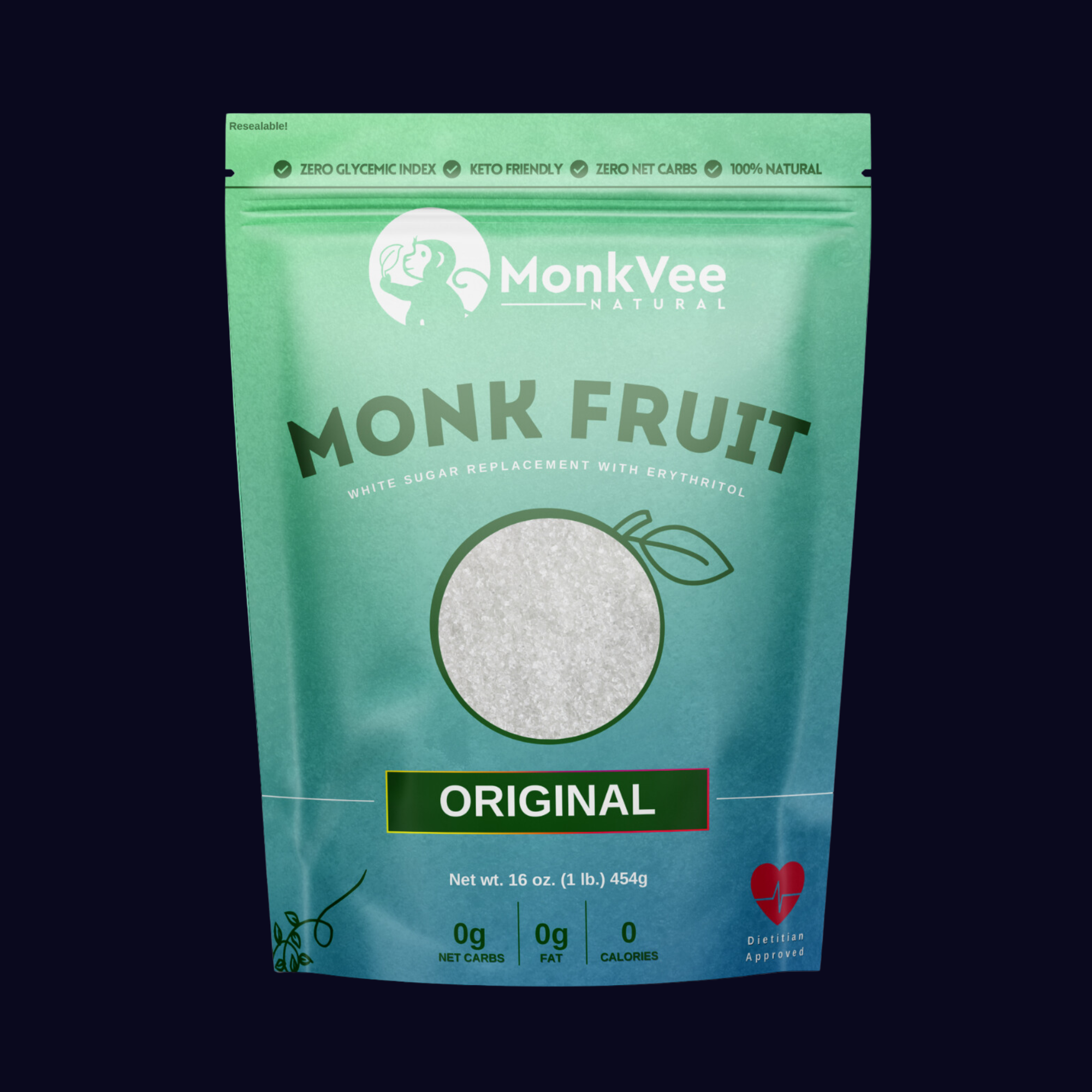
Unveiling the Process: How Monk Fruit is Made - A Complete Guide
How Monk Fruit Is Made: From Plant to Sweet Perfection
Monk fruit — the tiny, green, gourd-like fruit native to southern China — has been prized for centuries in traditional Chinese medicine. But in recent years, it’s found its place in kitchens around the world as a zero-calorie, all-natural sweetener. So, how do we go from a fresh monk fruit to a concentrated sweetener that's up to 150–300 times sweeter than sugar? Let's dive into the process and uncover the magic of monk fruit sweetening.
From Vine to Sweetness: The Monk Fruit Production Process
Monk fruit (also called luo han guo) looks innocent enough — kind of like a lime on vacation. But inside this small fruit is a powerhouse of sweetness. The key sweet compounds are called mogrosides, which aren't sugars at all but unique antioxidants that deliver a super-sweet punch without the calories or blood sugar spikes of regular sugar.
The journey of how monk fruit becomes a sweetener looks something like this:
1. Growing and Harvesting
Monk fruit is primarily grown in the misty mountains of Guangxi province, China. The plant requires a specific climate to thrive: warm, humid, and high-altitude — not exactly your average backyard veggie. The fruits are hand-harvested at peak ripeness.
2. Drying (for Some Uses)
In traditional applications, monk fruit is simply dried and used in teas and herbal remedies. But for sweetener production, it takes a different path.
3. Crushing and Juicing
The fresh fruits are crushed to release their juice, which contains the ultra-sweet mogrosides.
4. Filtration and Purification
The juice is filtered to remove any solids, and then purified using a water-based process. This eliminates undesired flavors and extracts just the mogrosides — no added chemicals, just good ol’ science and water.
5. Drying Into Powder
The purified mogroside extract is then dried — usually via spray-drying — into a fine, concentrated powder. At this point, it's hundreds of times sweeter than sugar by weight. That’s what ends up in products like MonkVee Pure Monk Fruit.
Quick Buyer Checklist
- Choose 100% pure monk fruit if you want the cleanest, most concentrated form — like MonkVee Pure Monk Fruit (no erythritol).
- Looking for a sugar-for-sugar substitution? Go for MonkVee Golden Monk Fruit or MonkVee Original. These blends use a touch of erythritol simply to match sugar’s bulk, texture, and 1:1 usage.
- Avoid fillers like maltodextrin, dextrose, or artificial sweeteners — MonkVee never uses them.
- If it says "monk fruit blend," check the ingredients. With MonkVee, transparency is guaranteed.
Pro Tips and How to Use
- Pure MonkVee Monk Fruit is super potent. A pinch goes a long way — perfect for beverages, smoothies, and energy bites.
- Want to bake with ease? Use MonkVee’s 1:1 Original or Golden Monk Fruit. They measure just like sugar — no math needed.
- When swapping sugar in recipes, taste as you go (especially with pure extract — it packs a punch).
Conversion Ratio Table
| MonkVee Product | Sugar Ratio | Usage Notes |
|---|---|---|
| MonkVee Stevia Extract (Reb A) | 300x sweeter than sugar | Use tiny amounts; ideal for drinks and cold uses |
| MonkVee Pure Monk Fruit | 150x sweeter than sugar | Use sparingly; great in smoothies, sauces, and no-bake recipes |
| MonkVee Golden & Original Blends | 1:1 with sugar | Best for baking and cooking — cup for cup replacement |
What You Can Use MonkVee Products In
- Baking (cookies, cakes, muffins, brownies)
- Drinks (coffee, tea, lemonade, smoothies)
- Homemade sauces, jams, dressings
- Snacks (protein balls, chia pudding, oatmeal)
Basically — wherever sugar goes, MonkVee goes better (and guilt-free).
Health Benefits of Ditching Added Sugar
Less sugar doesn’t mean less joy. Swapping out added sugar for MonkVee’s sweet alternatives can:
- Support stable blood sugar
- Reduce overall calorie intake
- Support dental health (sugar won’t rot your teeth if there’s no sugar!)
- Lower your risk for metabolic issues
- Help break free from sugar cravings
Dietitian’s Tips About Eating Healthy
- Read your labels — added sugars hide in surprising places
- Balance your plate with whole foods — not just low-cal sweeteners
- Add fiber, protein, and healthy fats to keep blood sugar stable
Losing Weight by Cutting Added Sugar
Switching from sugar to monk fruit is a smart move, but it’s not a magic fix. Real, lasting weight loss requires a well-rounded lifestyle: movement, hydration, whole foods, and yes — delightfully sweet, zero-calorie treats from MonkVee (perfectly acceptable).
Why MonkVee’s All-Natural Sweeteners Are Better Than Lab-Made Ones
Unlike synthetic sweeteners like aspartame or sucralose, monk fruit comes from the earth — not a petri dish. MonkVee’s products are non-GMO, zero calorie, and preservative-free. Our blends that contain erythritol use it as a naturally fermented bulking agent — it’s already produced in small amounts by your own body and is considered one of the safest sugar alcohols. No aftertaste, no bitterness, just smooth, clean sweetness.
Buy the Best Natural Sweeteners at MonkVee.com
Whether you're keto, diabetic, health-conscious, or just sugar-weary — MonkVee has your back. From pure extracts to convenient 1:1 blends, our monk fruit-based options are clean, versatile, and delicious. Sweeten smarter at MonkVee.com.
TL;DR: Common Issues & Simple Fixes
- Too sweet? Use less. A teeny pinch of pure monk fruit goes a long way.
- Weird aftertaste? That usually means it isn’t pure monk fruit. Stick with MonkVee.
- Can’t bake with it? Use MonkVee Golden or Original — they're 1:1 with sugar.
- Inconsistent sweetness? Stir thoroughly — sweeteners can settle.
- Cake too dry? Add applesauce or yogurt to compensate for sugar’s moisture.
- Digestive issues? Pure monk fruit doesn’t usually cause problems. Blends with erythritol are very well-tolerated.
- Doesn’t melt like sugar? Pure monk fruit won’t caramelize. Use MonkVee Golden for better texture in cooked recipes.
- Confused by labels? If you can’t pronounce it, don’t eat it. MonkVee keeps it real (and pronounceable).
Top 10 Q&A About Monk Fruit and MonkVee Products
1. Is monk fruit safe for kids?
Absolutely — monk fruit is non-toxic and safe for all ages. Just don’t let them dump in a tablespoon thinking it’s sugar!
2. Can I use monk fruit if I’m diabetic?
Yes. Monk fruit has no glycemic impact and won’t spike blood sugar — perfect for people with diabetes or those managing carbs.
3. Does monk fruit have an aftertaste?
Pure monk fruit is smooth and sweet. If you’ve experienced bitter aftertastes, it’s likely from a poor-quality blend or added fillers — not MonkVee!
4. Is erythritol safe?
Yes! It occurs naturally in fruits and your own body. It’s gentle on digestion and only used in MonkVee 1:1 blends as a bulking agent.
5. Can I bake with it?
You bet. Use our MonkVee Original or Golden blends for a perfect cup-for-cup sugar replacement in baked goods.
6. Will monk fruit caramelize like sugar?
Pure monk fruit doesn’t caramelize, but MonkVee’s Golden blend offers 1:1 sugar swap with better browning and texture.
7. How does MonkVee Pure Monk Fruit compare to other brands?
MonkVee is 100% pure, with no fillers, bulking agents, or mystery ingredients. Many “monk fruit” blends out there are mostly erythritol or dextrose — read your labels!
8. Does MonkVee Stevia have any bitter notes?
Our MonkVee Stevia is Reb A processed, the cleanest-tasting component of the leaf — no bitterness, just sweetness.
9. Can I add monk fruit to coffee?
Absolutely. MonkVee Pure Monk Fruit or Stevia blends perfectly into hot or cold beverages — zero calories, maximum joy.
10. What if I use too much?
Pure extracts are potent. If you accidentally over-sweeten, adjust the recipe or dilute to taste. Start small — you can always add more!
So there you have it — monk fruit isn’t just another sweetener. It’s a delicious, centuries-old wonder made modern by science — and made even better by MonkVee. Go ahead, sweeten life naturally — your body (and taste buds) will thank you.
Calorie Calculator

Build Your MonkVee® Box
Ditch the sugar & lab made sweeteners for good!
Glycemic Index Calculator
Click product for details and to upgrade to Subscribe & Save
Try MonkVee®
Mac: Command + F to find your question
Commonly Asked Questions
Why use Monk Fruit Sweetener?
MonkVee® Monk Fruit Sweeteners are 100% natural and zero calories. Unlike sugar which is known to be the leading cause of dozens of awful chronic illnesses such as certain cancers, diabetes, and other killers. MonkVee® Monk Fruit (and Stevia extract) are the healthiest known sweeteners available on the market today. Unlike lab-made artificial sweeteners, MonkVee® is your #1 choice for pure, natural, delicious sweetness. No More sugar spikes and sugar crashes, jitters, diseases, tooth decay and cavities... The list goes on. Try MonkVee® and enter the sweet life!
Will monk fruit sweetener activate yeast
Monk fruit doesn't activate yeast like sugar does, however, by using MonkVee® Monk Fruit, you can reduce the sugar in your recipe overall and have a much healthier outcome! And it will taste just as good! See our full article about baking with monk fruit here.
What is monk fruit?
Monk fruit, also known as luo han guo, is a small green melon native to Southeast Asia. It's valued for its sweetness and health benefits.
How is monk fruit sweetener made?
Monk fruit sweetener is made by extracting the natural sugars from the monk fruit, resulting in a concentrated sweetener that is much sweeter than sugar.
Is monk fruit sweetener a good sugar alternative for baking?
Yes, monk fruit sweetener can be used as a sugar alternative in baking. It provides sweetness without the calories or blood sugar spikes associated with regular sugar.
Does monk fruit sweetener have any calories?
Monk fruit sweetener is calorie-free, making it an excellent option for those watching their calorie intake.
Can monk fruit sweetener be used by people with diabetes?
Yes, monk fruit sweetener is a suitable option for people with diabetes because it does not affect blood sugar levels.
Is monk fruit sweetener safe for weight loss diets?
Monk fruit sweetener can be a helpful tool for those on weight loss diets as it provides sweetness without the calories of sugar.
Does monk fruit sweetener have an aftertaste?
Monk fruit sweetener typically does not have an aftertaste, especially when compared to other artificial sweeteners.
Can monk fruit sweetener help with acne?
While there's no direct evidence linking monk fruit sweetener to acne, reducing sugar intake, including monk fruit sweetener, may contribute to clearer skin for some individuals.
Does monk fruit sweetener affect sleep quality?
Monk fruit sweetener does not directly affect sleep quality. However, consuming it in excess before bedtime may lead to digestive discomfort, which could impact sleep.
Are there any known side effects of consuming monk fruit sweetener?
Monk fruit sweetener is generally recognized as safe (GRAS) according to the FDA.
Can monk fruit sweetener be used in hot beverages like coffee or tea?
Yes, monk fruit sweetener can be added to hot beverages like coffee or tea to sweeten them without adding calories.
Is monk fruit sweetener suitable for vegan diets?
Yes, monk fruit sweetener is vegan-friendly as it is derived from the fruit and does not contain any animal products.
How does monk fruit sweetener compare to other natural sweeteners like stevia?
Monk fruit sweetener and stevia are both natural sweeteners with zero calories, but monk fruit is often considered to have a cleaner, more sugar-like taste.
Can monk fruit sweetener be used in cold beverages?
Yes, monk fruit sweetener can be used to sweeten cold beverages like iced tea or lemonade without any issues.
Does monk fruit sweetener contain any artificial ingredients?
No, monk fruit sweetener is made from the natural sugars found in the monk fruit and does not contain any artificial ingredients.
Can monk fruit sweetener be used in recipes that require caramelization?
Monk fruit sweetener can be used in recipes that require caramelization, but it may not caramelize in the same way that sugar does.
Can monk fruit sweetener be used in homemade jams and preserves?
Yes, monk fruit sweetener can be used to sweeten homemade jams and preserves instead of sugar. It will provide sweetness without adding extra calories.
Does monk fruit sweetener have a glycemic index?
Monk fruit sweetener has a glycemic index of zero, meaning it does not raise blood sugar levels.
Can monk fruit sweetener be used in raw desserts?
Yes, monk fruit sweetener can be used in raw desserts to add sweetness without the need for cooking or baking.
Is monk fruit sweetener suitable for people with gluten intolerance?
Yes, monk fruit sweetener is gluten-free and can be safely consumed by people with gluten intolerance or celiac disease.
Can monk fruit sweetener be used in homemade salad dressings?
Yes, monk fruit sweetener can be used to sweeten homemade salad
Is monk fruit sweetener suitable for people following a ketogenic diet?
Yes, monk fruit sweetener is suitable for those on a ketogenic diet as it does not contain any carbohydrates or sugars that could affect ketosis.
Can monk fruit sweetener be used in beverages other than tea and coffee?
Absolutely! Monk fruit sweetener can be used in various beverages like smoothies, cocktails, and flavored water to add sweetness without the extra calories.
Does monk fruit sweetener affect blood sugar levels?
No, monk fruit sweetener does not affect blood sugar levels as it has a glycemic index of zero. It's a suitable option for those monitoring their blood sugar.
Is monk fruit sweetener safe for pregnant women?
Monk fruit sweetener is generally considered safe for pregnant women, but it's always best to consult with a healthcare professional for personalized advice.
Can monk fruit sweetener be used in homemade granola bars?
Yes, monk fruit sweetener can be used in homemade granola bars to provide sweetness without the added sugar. It's a healthier option for snacks.

